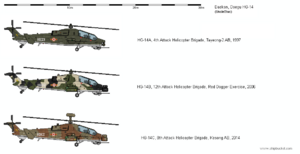Daegu HG-14: Difference between revisions
No edit summary |
No edit summary |
||
| Line 39: | Line 39: | ||
==Operational history== | ==Operational history== | ||
==Operators== | |||
*{{flag|Daekan}}: The Daekanese People's Army Ground Force Aviation Command operates 150 HG-14s of all variants. 100 more are expected to be produred. | |||
*{{flag|Pakiranistan}}: | |||
==Variants== | ==Variants== | ||
*'''HW-010-1:''' Prototype variant. It featured the Daegu ET-100A turoshaft engines and large, three-hardpoint wings. | |||
*'''HW-010-2:''' Second prototype variant. Smaller, two hardpoint wings and improved avionics. | |||
*'''HW-010-3:''' Third prototype variant. Improved ET-300A turboshaft engines and altered cockpit design. | |||
*'''HG-14A:''' First production variant. Characterised by the ball-shaped EO gimbal on the nose. | |||
*'''HG-14B:''' Upgraded variant introduced in 2005. Features an upgraded EO and avionics suite, as well as improved armour panneling. | |||
*'''HG-14C:''' Further modernisation introduced in 2014. Improved ECM, infared jammer and radar warning receiver. Most notably, it mounts the LS/H-12 millimeter-wave fire-control radar housed in a dome above the rotor. It also features the upgraded ET-400A engines. | |||
*'''HG-14H:''' Naval variant with nose mounted radar among other changes. Prototype only. | |||
==Specifications (HG-14)== | ==Specifications (HG-14)== | ||
Revision as of 11:15, 16 November 2020
This article is incomplete because it is pending further input from participants, or it is a work-in-progress by one author. Please comment on this article's talk page to share your input, comments and questions. Note: To contribute to this article, you may need to seek help from the author(s) of this page. |
| Daegu HG-14 | |
|---|---|
 Main HG-14 variants | |
| General information | |
| Type | Attack helicopter |
| Manufacturer | Daegu Aircraft Company |
| Status | In service |
| History | |
| Manufactured | 1993 |
| Introduction date | 9 April 1994 |
The Daegu HG-14 (헬리콥터, 공격 14; Helicopter, Attack (No.) 14) is a Daekanese twin-engine, twin tandem cockpit attack helicopter. Designed and produced by the state-owned Daegu Aircraft Company, the HG-14 makes up the backbone of the Daekanese People's Army Ground Force's attack helicopter fleet. The HG-14 is an all weather, day-night attack helicopter optimised for the anti-tank role, and carries a nose mounted sensor suite for target detection and acquisition. The helicopter is armed with a chin-mounted GW-16/23 23mm chain gun, and features pylons under each stub wing that are able to mount a variety of ordnance.
Origins and development
Daekan became interested in attack helicopters early on in their developement. The country's number one defensive priority was a large-scale land war on the long border with Esgonia, and a dedicated attack helicopter for close air support (especially in the anti-armour role) was deemed necessary. Daekan first secured the sale of 40 Mi-24Ds from Vanquaria in 1978, with the aircraft delivered the same year. While overall liking the aircraft and its capabilities, the Daekanese military leadership considered it cumbersome and overly large, while its secondary transport capability was seen as next to useless was seldom used save for special forces insertions. Plans were drafted to design and produce a domestic attack helicopter, but the disastrous 7th Five-Year Plan and the Daekanese economic crisis put a halt to those plans. The military, however, still demanded an attack helicopter. In 1979, domestic production rights for the Mi-24 were secured, with first factory being opened in 1980.
The Mi-24 remained the DPA's main attack helicopter throughout the 1980s, with production picking up in the latter half of the decade as Maeng Song-Hun's reforms revitalised the economy. The concept of a domestically designed attack helicopter was again brought up. The technology and information transfer for the GK-Valaran Agusta A129 Mangusta in the late 80s had many suggesting a copy of that design, but the DPA leadership decided against it for both political and design reasons. The plans were used to design the Daegu HU-10 utility helicopter instead.
In 1991, the government officially started the competition for a new attack helicopter design. The Daegu-based Daegu Aircraft Company's design, a four-blade, tandem seat design with engines based on the A129's Rolls-Royce Gem 2-1004D, garnered particular interest. After going through several reiterations, the prototype made its maiden flight in 15 September 1992. The second prototype crashed due to engine failure later that year, and the engines were reworked and improved. The third prototype performed a demonstration for DPA officials in 1993. The type was officially adopted and given its official DPA designation "HG-14" later that year. The first batch of helicopters was delivered to the 12th Attack Helicopter Brigade in 1994.
Design
Airframe
Engines
Electronics and Avionics
Armaments
Operational history
Operators
 Daekan: The Daekanese People's Army Ground Force Aviation Command operates 150 HG-14s of all variants. 100 more are expected to be produred.
Daekan: The Daekanese People's Army Ground Force Aviation Command operates 150 HG-14s of all variants. 100 more are expected to be produred. Pakiranistan:
Pakiranistan:
Variants
- HW-010-1: Prototype variant. It featured the Daegu ET-100A turoshaft engines and large, three-hardpoint wings.
- HW-010-2: Second prototype variant. Smaller, two hardpoint wings and improved avionics.
- HW-010-3: Third prototype variant. Improved ET-300A turboshaft engines and altered cockpit design.
- HG-14A: First production variant. Characterised by the ball-shaped EO gimbal on the nose.
- HG-14B: Upgraded variant introduced in 2005. Features an upgraded EO and avionics suite, as well as improved armour panneling.
- HG-14C: Further modernisation introduced in 2014. Improved ECM, infared jammer and radar warning receiver. Most notably, it mounts the LS/H-12 millimeter-wave fire-control radar housed in a dome above the rotor. It also features the upgraded ET-400A engines.
- HG-14H: Naval variant with nose mounted radar among other changes. Prototype only.